| کد مقاله | کد نشریه | سال انتشار | مقاله انگلیسی | نسخه تمام متن |
|---|---|---|---|---|
| 5022360 | 1469488 | 2016 | 27 صفحه PDF | دانلود رایگان |
عنوان انگلیسی مقاله ISI
Synthesis and characterization of lignin carbon fiber and composites
ترجمه فارسی عنوان
سنتز و مشخصه فیبر کربن لیگنین و کامپوزیت
دانلود مقاله + سفارش ترجمه
دانلود مقاله ISI انگلیسی
رایگان برای ایرانیان
کلمات کلیدی
موضوعات مرتبط
مهندسی و علوم پایه
سایر رشته های مهندسی
مهندسی (عمومی)
چکیده انگلیسی
In this study, continuous lignin fibers from switchgrass have been successfully synthesized via multifilament melt-spinning and converted to carbon fibers using optimized stabilization and carbonization techniques. Unidirectional lignin carbon fiber reinforced composites are produced using a vacuum assisted resin transfer molding process for the first time. Produced lignin carbon fiber is evaluated in mechanical, interfacial, and microstructural areas. Single fiber mechanical properties are characterized using a unique MTS Bionix Nano-UTM. Interfacial properties and resin/fiber behavior are evaluated using single fiber fragmentation. Microstructural properties are determined using wide-angle x-ray diffraction. Mechanical results indicated an initial tensile modulus along fiber axis of 36 GPa and a failure stress of 600 MPa for single carbon fibers. Lignin carbon fibers demonstrate a nonlinear increase in modulus with applied tensile strain similar to recently observed for commercial poly-acrylonitrile (PAN) carbon fibers. Microscopy revealed few defects within and along the lignin carbon fibers, and the processed lignin fibers demonstrated minimal crystalline regions and crystallite alignment when compared to commercial PAN based fibers. Interfacial shear strength with epoxy resin was found to be 17 MPa with a fiber fracture length of 228 μm. Unidirectional composite coupons achieved tensile modulus of 9 GPa and a failure strength of 85 MPa at 1% failure strain. Lignin carbon fiber and composites produced are targeted for non-structural applications as mechanical properties are currently less than PAN carbon fibers and therefore are not suitable to replace PAN carbon fiber at this stage. Relatively low composite strength is the likely result of fiber layup, fiber fusing, and non-continuous fibers across the gage length of the composite. Nano-tensile and interface shear strength results presented here have important implications for lignin carbon fiber composite development to optimize fiber/resin bonding. In addition, composite manufacturing procedures detailed here are a major step forward in the development of sustainable carbon fiber composite production.
ناشر
Database: Elsevier - ScienceDirect (ساینس دایرکت)
Journal: Composites Science and Technology - Volume 137, 12 December 2016, Pages 60-68
Journal: Composites Science and Technology - Volume 137, 12 December 2016, Pages 60-68
نویسندگان
Nathan Meek, Dayakar Penumadu, Omid Hosseinaei, David Harper, Stephen Young, Timothy Rials,
